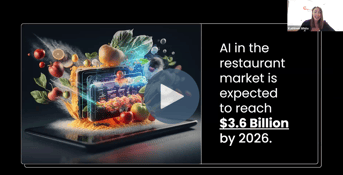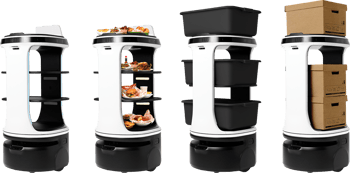PLNT Burger is growing fast. After opening two brick-and-mortar restaurants in New York City, the vegan burger shop recently announced it’s opening three more, with plans to expand to 30 locations across Washington D.C., New York City, Boston, Maryland, and Pennsylvania by the end of 2023.
But the fast-casual – known for serving Beyond Meat burgers with toppings like mushroom “bacon”, guacamole, and vegan pepper jack cheese – comes from far smaller origins. It was late 2019 when PLNT Burger launched its first concept, housed inside a 150-square-foot kiosk in a Whole Foods Market in Maryland.
“We just didn’t have that much space, and that allowed us to build a concept around efficiency,” says co-founder and CEO Ben Kaplan.
With a streamlined menu of plant-based eats, Kaplan says PLNT Burger gained traction quickly. But it’s when the pandemic hit that the brand really started to flourish. Whole Foods was deemed an essential pandemic business, which allowed PLNT Burger to stay up and running while other restaurants closed. Soon, the brand expanded into 10 additional Whole Foods locations.
We sat down with Kaplan to learn more about what he’s learned from the kiosk business model and his thoughts on the future of the plant-based restaurant space.
I’m curious about the decision to launch out of a kiosk. Can you share a little more about PLNT Burger’s origins?
Sometimes decisions are conscious, and then sometimes they’re an effect of the marketplace. We made a 100% conscious decision in December 2019 to go into Whole Foods for a large host of reasons.
That was a time when Beyond Meat just had its IPO and the [plant-based meat] space was really trending. There was still a newness of it all. We thought we had a good idea, but we didn’t know what our sales volume would really look like or who our ultimate end user was. Whole Foods offered a lot of protection to the classic restaurant problems. And in our minds, it became a way into a customer base that would already have an affinity for our product in some way, even if it was just that they were willing to be discovery consumers, or conscious consumers.
We learned a ton in the first six months about who really demanded this product. There was more demand not from a high-paying consumer or a consumer looking for a special treat, but more from a customer that says, “Hey, I need better fast food. This happens to be plant-based, but it also doesn’t have soy, and it tastes great.” We put a lot of emphasis on being chef-crafted. My business partner, Spike Mendelsohn, is a former Top Chef and a fine dining, French trained chef, so he thinks about burgers in a very deep way in terms of taste.
We also learned a ton about keeping the operation streamlined and making sure we didn't overbuild the menu or put a lot of labor into prep because we just didn’t have that much space. We had 150 square feet. That allowed us to build a concept around efficiency.
PLNT Burger has since expanded into 11 Whole Foods. Do you feel like the kiosk model set you up to grow, and can you share what that expansion looked like?
We say, “Hey Whole Foods, we’re doing pretty well. We’d love to think about other locations.” As a company, we started hunting for some real estate. And then the pandemic hit.
We had a choice to truncate and hold off or look at the opportunity here. What we immediately recognized was, we’re a business inside an essential business. That’s where the market made certain choices for us. Whole Foods had a very robust prepared food model, but as soon as pandemic restrictions said you couldn’t serve open service salad bars anymore, they had to make a full adjustment.
That created an opportunity for us to go into venues and cook burgers. It was a strong pandemic opportunity to grow a brand. We grew very quickly, and as the pandemic rounded out, we made a conscious choice to look for real estate on the street and see if there were opportunities that made sense. We placed a pretty big bet on New York [City].
You mentioned the kiosk model forced efficiency – what were some of the top efficiency takeaways you learned?
When you only have a very tight kiosk space, it limits the amount of ingredient pans you can have on the line. With new concepts, there’s an attraction to service every need of every customer, and launch 15 different protein options, or whatever the decision is when you have the space to support that. Overbuilt spaces also provide additional storage of goods, and that extra space can sometimes lead to over ordering and inefficiencies in your inventory management.
The physical footprint dictated that we needed to keep the menu tight, and it’s one of the best decisions we ever made. It allows us to focus on marketing efforts for those products, and we only end up with things that sell because we don’t have space for anything else.
I imagine there are also challenges in working within a 100-something-square-foot kiosk that aren’t as easy to spin into a positive. Can you share any advice for entrepreneurs who might be looking to test out this option?
One, you don’t have the physical street presence. You’re still inside of another business, so your immediate radius of customers is cut off by their front door. We’re lucky to be a very digital-forward company, and a lot of our business happens off-premise, but it’s a challenge. It requires a level of marketing that gets your brand out there in ways other than having a great location.
The other challenge is just throughput. If you know that 90% of your business is going to be Monday through Friday from 11 [a.m.] to 3 [p.m.] because you're in an office district, you physically can’t get through as many orders as you could in a larger footprint. You start to hit capacity. It’s not that we’re busy all the time, but it’s about learning how to take advantage of those peaks from a throughput perspective.
You guys created a PLNT Burger app. Can you share how you’re leveraging that with customers and the importance you see it playing in the success of the business?
It’s definitely our entry point into that off-premise world. Instead of having to discover us on a marketplace like Uber Eats, we have the ability to get our store out there in a digital way – from an Instagram billboard to a TikTok video – and draw orders into our direct order channel. So it’s getting us new customers but then it becomes the platform where we can have that ongoing relationship with loyal guests, and that’s where it’s added the most value. It’s really one of our huge value propositions. On average, we’re giving a 10% discount to loyalty members.
In January, the first PLNT Burger brick and mortar opened. How did you decide it was time to make the leap to something bigger?
Ultimately, we wanted higher throughput spaces and spaces with higher sales capacities. We believe as a group, this first post-pandemic restaurant has to be getting to customers wherever they are. We launched our brand in D.C., but there was a great market fit in New York [City]. And we really saw an opportunity in the rental marketplace there.
And the goal is to have 30 brick and mortar restaurants by the end of 2023, correct?
We’re shooting high with that number, frankly. Not brick and mortars – 30 units total. It’ll always be a blend of traditional and nontraditional strategies..
We’re seeing an overall uptick in fast casuals in today’s climate, but I’m curious what role do you think the 100% plant-based menu plays in your success?
We’re really trying to emulate a better quick-service burger. We’re following great business models in the burger business. But in terms of setting ourselves apart, the differentiator is certainly the plant-based model.
We really believe there’s a growing eco-anxiety around climate change. And then the biggest education leak is, what you eat is your number one chance every day to make an impact on the climate. It’s not using paper straws and making sure you’re an avid recycler. It’s what you put in your body and what you choose to support as a food ecosystem. That being said, we don’t want people to have to sacrifice what they want, their burger cravings and desires.
I think people will learn that eating is going to have a global effect on climate change. That’s where I think the brand grows long-term. I only see that educational piece becoming more prevalent.
Where do you see the plant-based restaurant space continuing to grow in the future?
You’re going to see more plant-based innovation showing up on menus. There will be more choices across the entire industry. You’re already seeing it in places like Starbucks. As opposed to just having one alternative option, there will be two, and then there will be five. I don’t think the entire space will go vegan by any means, but you’ll have a shift in the menu mix.
I’m sure you guys know chicken wings were out for a long time and that was labor related and supply chain related. Whether it’s a loss of subsidies or the supply chain itself, the insane costs [of meat] can’t just be passed onto consumers. Things are going to need to change, we’re going to need alternatives, and that’s changing with a consciousness around our food system.
I got into plant-based because I was curious. I wasn’t a plant-based person. But it’s exposed me to a lot of purpose in my career, and I think it’s worth sharing that with other operators. It’s not just a weird trend we all have to try and implement in our restaurants – it really can be meaningful. Something that the supply chain has allowed for is to go about it in normative ways, and that’s where I think the most success is going to be had. You don’t have to challenge the customer to jump over a bunch of hurdles.
Beyond expanding in number of units, are there any other ways you envision PLNT Burger continuing to grow in the future?
We really see lots of avenues for PLNT Burger – ideally in the virtual dining space with other partners, licensees, or franchises. I see this as being something that’s easy to adopt because of the streamlined menu. Across licensee landscapes, I think this is a good airport concept, a good concept for other travel destination venues, an alternative concept for stadiums – I see those kinds of models for growth.
Our sister company, Eat the Change, born by one of our co-founders Seth Goldman, is already in the plant-based snack business. We’re not at the scale yet where we can produce our own products for ourselves, but that’s definitely on the road map. Because we have a background in retail, I do see us going in that direction, whether that’s with our sauces or our own special meat iterative. It’ll be supplementary to our business.





